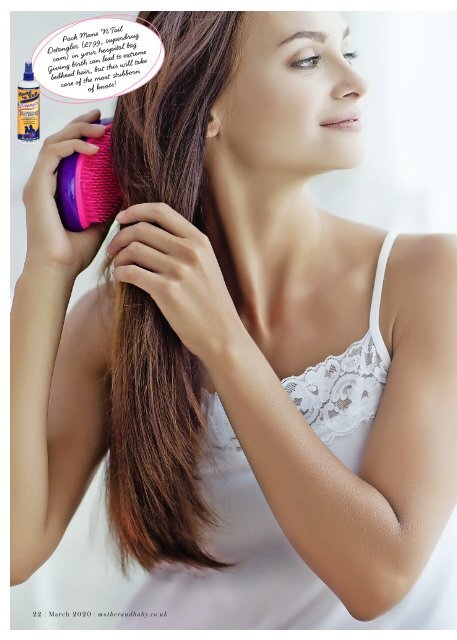Mother&Baby Mar20
Create successful ePaper yourself
Turn your PDF publications into a flip-book with our unique Google optimized e-Paper software.
FEATURE NAME<br />
Pack Mane ‘N Tail<br />
Detangler (£7.99, superdrug.<br />
com) in your hospital bag.<br />
Giving birth can lead to extreme<br />
bedhead hair, but this will take<br />
care of the most stubborn<br />
of knots!<br />
During pregnancy you expect<br />
to look and feel different –<br />
after all, there’s a whole lot<br />
of impressive stuff going on<br />
inside you to help grow a<br />
baby! But changes to your<br />
hair can be a lot more unpredictable – you<br />
may be blessed with the most voluminous,<br />
shiny hair you’ve ever had, or experience<br />
oiliness or a change in texture – all of which<br />
are completely normal. ‘Pregnancy hair varies<br />
from woman to woman,’ says trichologist<br />
Anabel Kingsley. ‘Some pregnant ladies<br />
experience lots of changes to their hair, while<br />
others don’t notice anything at all. Hair can<br />
even react differently in different pregnancies.<br />
Just like pregnancy skin, sometimes it improves,<br />
sometimes it doesn’t. Rest assured, though,<br />
your hair will be back to your hair – possibly<br />
with added perks – around a year after having<br />
your baby.’ So, stay positive and remember:<br />
there are ways of handling the changes so you<br />
can experience lots more good hair days!<br />
THE THICK OF IT<br />
‘The most common hair change reported by<br />
pregnant ladies is fuller locks,’ says Anabel.<br />
‘But you’re not magically growing more hair<br />
– this thickness happens because you’re losing<br />
less hairs daily than you would normally. The<br />
average person usually loses around 100 hairs<br />
a day as part of the natural hair cycle. But<br />
when you’re pregnant, increased oestrogen<br />
levels, which soar during the first trimester<br />
and continue into the other two, cause your<br />
hair to sit in the growth phase of the hair<br />
cycle for longer, so hair shedding is delayed.<br />
This means you only lose around 20 hairs a<br />
day.’ It’s this strand build-up that gives you<br />
the appearance of thicker hair.<br />
‘Some women are convinced their hair is<br />
growing longer, too,’ says Anabel. ‘But strands<br />
can only grow half an inch a month. So,<br />
this is just a perceived concept thanks<br />
to the thickness.’ This thickness<br />
makes any hair style look<br />
amazing, but you might need to<br />
take smaller sections when<br />
curling or straightening to<br />
get good results. And, when<br />
pinning your hair up,<br />
double up and use grips<br />
lapped over each other<br />
across the grooves at each<br />
end, for added support.<br />
THINLY VEILED<br />
At the other end of the<br />
strand-scale, you may<br />
experience hair loss – known as<br />
shedding. While this is most likely<br />
to occur post-baby, it can also strike<br />
Colour<br />
crisis?<br />
Deciding whether<br />
to colour your hair<br />
when pregnant is a<br />
personal choice.<br />
Your scalp can be<br />
more sensitive,<br />
so an adverse<br />
reaction could<br />
happen even if<br />
you’ve had<br />
treatments for<br />
years – do a patch<br />
test first.<br />
Whatever you<br />
decide, once<br />
you’ve had your<br />
baby a trip to the<br />
salon can help<br />
your hair’s<br />
appearance. ‘Visit<br />
a good colourist<br />
who won’t<br />
over-process your<br />
post-partum hair,’<br />
advises Anabel.<br />
‘Also work to<br />
reduce the<br />
contrast between<br />
your scalp and hair<br />
colours in order to<br />
make hair appear<br />
fuller when that<br />
shedding starts.’<br />
Little<br />
fluffers<br />
During the fourth trimester, as all those<br />
old hairs start shedding on mass, new hairs<br />
must grow. Which means baby hairs are pretty<br />
much inevitable. ‘It’s actually when your hair<br />
starts to grow back that you notice how much<br />
you’ve lost,’ says Anabel. ‘You do lose hairs from<br />
your crown, but it’s most noticeable around your<br />
temples and above your ears, as you see these<br />
areas daily. Ride these wispy bits out – your<br />
baby is the reason why they are there,<br />
it’s out of your control, and every<br />
baby hair is one hair closer to<br />
getting your former<br />
locks back.’<br />
Bump&Birth<br />
during pregnancy. ‘Morning sickness can<br />
contribute to shedding,’ explains Anabel.<br />
‘Your hair needs nutrients to grow, but the<br />
essentials go to your baby first. Gestational<br />
diabetes, coming off the contraceptive pill, and<br />
iron deficiency can also encourage shedding.<br />
Stress plays a part, too, especially when the<br />
shedding happens during the first trimester,<br />
or very soon into the second. The loss is a<br />
reflection of what happened three months<br />
earlier – tying into the hair cycle – so if you<br />
had a tough time getting pregnant or in the<br />
early days, your hair can react.’<br />
All these factors, and more, can contribute<br />
to hair loss once you have your baby. ‘Postpartum<br />
hair loss is reported to affect 50 per<br />
cent of women,’ says Anabel. ‘However,<br />
experts believe the figure is likely to be much<br />
higher, given what women go through to get<br />
their babies safely into the world. Then you<br />
need to consider the sudden dip of oestrogen,<br />
which happens after birth and takes effect on<br />
your hair around three months afterwards –<br />
or later if you’re breastfeeding.’ It kick-starts<br />
your hair cycle into a more typical time frame,<br />
so the shedding begins and it’s time to lose<br />
the hairs you’ve been building up over the<br />
previous nine months.<br />
It’s frustrating, but it isn’t forever. ‘About<br />
six months on, the shedding will go back to a<br />
typical hair growth and loss cycle,’ reassures<br />
Anabel. ‘Once your baby is here, or after you<br />
finish breastfeeding, it’s time to support new<br />
hairs as the increased shedding goes on.’ This<br />
means eating the right foods packed with iron<br />
– beetroot, spinach and steak are great – and<br />
keeping to regular meals as much as possible.<br />
Managing this stress, with the help of family<br />
and friends, will allow your hair to grow back<br />
stronger than ever – just like you.<br />
And while you’re experiencing shedding,<br />
you can make your hair feel thicker all over.<br />
You gotta love a mum bun – try plaiting<br />
your hair before you swirl it up into<br />
the bun, pin it in place and then<br />
pull at the sides of the plait to<br />
add volume. Or curl your hair<br />
in chunky sections – thinner<br />
hair bends so much quicker<br />
– to add width. It’s also<br />
worth using Lee Stafford<br />
Hair Growth Scalp<br />
Scrub (£8.99, boots.<br />
com) once or twice a<br />
week, to help things along.<br />
SHINY HAPPY HAIR<br />
Another hair wild card is<br />
how shiny your hair will<br />
go during pregnancy. ‘Your<br />
scalp produces less oils when<br />
you’re pregnant, which means<br />
22 | March 2020 | motherandbaby.co.uk motherandbaby.co.uk | March 2020 | 23

















